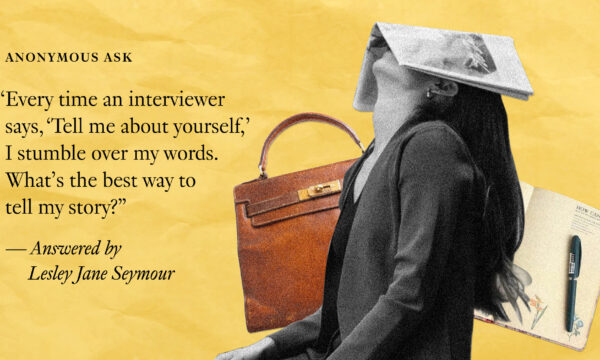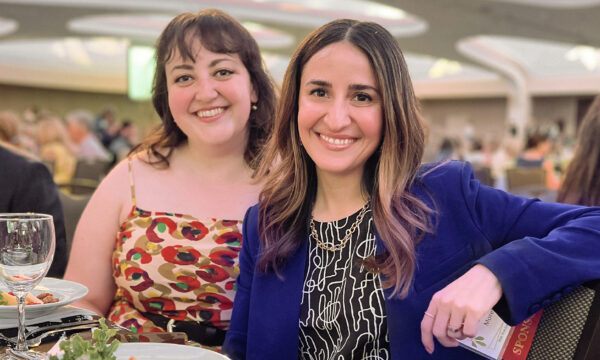
M.M.’s Director of People, Hanna, in her home garden. Shop Hanna’s shirt here.
What Having a Hobby Can Teach You About Work
Passion projects meet professional development.
Until last spring, when people would ask me, “What are your hobbies?”, I never had a great answer. Sometimes, I unconvincingly replied, “I love to cook?” but always felt a little silly rebranding such a common life skill to sound more niche. Then, quarantine came around, and my boyfriend and I binge-watched The Great Pottery Throwdown. It’s essentially the ceramics version of The Great British Baking Show: Just replace flour with clay, retain the charming English accents, and—for better or worse—take Paul Hollywood out of the picture.
Finally, after admiring others’ pottery creations for a couple of years, we worked up the courage to take our own turn at “throwing,” and we’ve now been at it for about a year. While all of my pieces remain relatively small and often imperfect, I’m pretty proud of my progress and sincerely grateful for the patience I’ve gained along the way. It turns out that speeding through the creative process is not the path to the most solid, impressive end product. Sure, I’d always subscribed to the belief that “slow and steady wins the race,” but pottery has helped me connect with this idea more intuitively—which, in turn, has made me more mindful of how I pace myself at work.

A couple of my pottery creations.
In reflecting back on the lessons I’ve gleaned from my year of making bowls and vases, I was curious to know if any of my hobby-having colleagues shared similar feelings. Has their pastime of choice contributed to their professional development in any way? It turns out the answer was a resounding yes.
Below, four of my fellow M.M. employees reveal what they’ve been up to outside of work—and how having a hobby has helped their careers.
Want more M Dash?
Sign up for our weekly newsletter.
Thank you!
Cindy, Graphic Designer

Cindy’s GPU (graphics processing unit) and curious cat, Kiyo.
“Saying that ‘building a PC’ is my hobby kind of makes me sound like one of those superhero tech sidekicks—the one in the chair who sits in a dark room surrounded by tech, remotely hacking into security cameras. In reality, I wouldn’t say that ‘tech’ is something I’m all that interested in. Building a computer is actually a byproduct of two of my other hobbies: video gaming and crafting.
For context: I haven’t replaced my personal laptop in eight years. She sounds like she’s fighting for her life whenever I try to do anything, so I figured it was probably time to replace her. But, after looking at how expensive MacBooks are, it felt unnecessary to spend so much money when I already have a MacBook as my work laptop. MacOS is also notoriously bad at running video games, and while I love playing on consoles, I’ve missed out on playing certain games that were only released for desktop. It’s not uncommon for people who play video games to build their own PCs, so I figured, why not?
I’m still in the early stages: lots of research, product comparison, figuring out what kinds of parts are compatible with what, etc. It can be overwhelming, and sometimes I can’t dedicate as much time to it as I’d like. In short, it’s slow progress, but that’s actually something I’m relishing. I’m an impatient person by nature, often opting for immediate gratification over delayed satisfaction, so being forced to go slowly (while maintaining motivation) has been a valuable experience. When people ask me how this is going, I say, ‘Nothing is built,’ which is technically true, but I know I’m still making progress even when I don’t have something physical to show for it. Being a graphic designer, this has been a great reminder, since it’s often easy to feel like your work is somewhat useless until the visual product is 100% finalized. But now, I’m more comfortable with an unfinished product, knowing that the process is just as important as the product itself.
This project has also been a good exercise in getting in touch with myself and my needs. Some activities help me unwind after a long day, but this is not one of them. I have to be very mentally engaged when I’m working, and there have been times when I’ve needed to step back and tell myself, ‘I’m tired and not in the right mood for this.’ In those instances, I’ll put everything away and specifically carve out time to come back to researching/building when I’m in the right mindset. Without even realizing it, I’ve noticed that I’ve started to apply this mentality to my work. For a while, my own career development interests had taken a backseat to my sense of obligation, but recently, I’ve started to tune into what I actually enjoy working on. This has allowed me to be more honest with my manager and discuss how we can reallocate workload so I’m more focused on developing skills I’m genuinely passionate about.”
Hanna, Director of People

Hanna with one of her belladonna sprouts.
“I don’t have a particularly green thumb and, in fact, have lost many houseplants to neglect, but I’ve found a happy place in gardening. I volunteered on a local farm a few years ago, helping harvest for a few hours each week in exchange for a CSA (Community Supported Agriculture) share, and I loved spending my morning hours chatting with the team, listening to the birds, and pulling gorgeous vegetables out of the dirt. Now, since moving to an old farmhouse, I’ve been filling my lawn with garden plots so I can chase that feeling at home.
Of course, the most obvious lesson I’ve learned from gardening is patience. As a people operations director, the goal of so much of my work is to take a seed and cultivate its growth over time—whether we’re talking about a new hire, an employee’s career development, or a specific project. Waiting to see results can be hard, but gardening is a nice allegory—a reminder that the slow process will be worth it in the end. I always come back to one experience in particular: One season, I used too much ‘bloom’ fertilizer thinking I could rush my late-planted tomatoes to fruit on time. I ended up with so many blooms on the plants that they couldn’t all ripen into juicy, red tomatoes before the fall chill came in. Similarly, good programs for organizational culture don’t have a quick fix but instead require time and attention—without shortcuts.
Another lesson I’ve learned from gardening came from my experience tending to my poison garden—yes, you read that correctly. Courses in herbalism I devoured during lockdown quickly led me to take an interest in poisonous plants, their medicinal uses, and some amazing folklore they inspire. I’ve loved taking on the challenge of growing ‘baneful’ herbs, as these plants require even more care, attention, and caution than most edible plants. Some are incredibly hard to germinate (belladonna), others grow quickly and prick me with their itchy seed pods if I get too close (datura), and still more can only be handled with leather gloves, as their toxins can be absorbed through the skin (monkshood). I don’t have many ready uses for these plants (don’t worry, I’m not going out and poisoning anyone), but I love spending time getting to know their unique traits and the ways that they can be extremely dangerous or surprisingly beneficial.
In an effort to apply this knowledge to my work, I consider Paracelsus’s quote, ‘The dose makes the poison.’ Foxglove can kill a healthy person, but the digoxin inside increases your heart rate, so it can be used in small doses for heart medicines. Apples, on the other hand, are seen as totally edible and delicious produce, but if one were to eat 100+ apple seeds in a single day, they could be a victim of cyanide poisoning. This is all to say that the health and harm of these plants depend on how much is consumed. Similarly, at M.M., we value the pursuit of balance and the intersection of kindness and directness. It’s valuable to assess these principles alongside Paracelsus’s statement so that we can seek nuance in our work. Some situations require us to lean more heavily on the side of kindness, as directness would have a more negative impact, while others require directness to move forward and solve a problem. When you analyze the situation and apply the right amount of each, you can truly benefit your people and organization.”
Taylor, Senior Retail Manager

Posts from Taylor’s bookstagram account, @tayreadsalot.
“Like many people, I discovered my hobby due to a craving to connect with others during the height of the pandemic. At the time, I had a renewed interest in reading, driven by the feeling that I’d fallen off the bandwagon in recent years and wanted to reignite my love of books. As a first step, I turned to Instagram to see what people were reading and discovered a corner of Instagram dubbed ‘bookstagram,’ where people create content centered around books, authors, and other reading-related things like bookstores and coffee shops. After some scrolling, I decided this would be my new ‘thing’ and started my own account, @tayreadsalot.
I dove into fostering my account and found there was so much to learn, from how to create Reels to a plethora of acronyms I had never heard of: ARC (advanced reader copy), DNF (did not finish), TBR (to be read)—the list goes on. Working on my bookstagram showed me that there’s so much for me to learn out there, whether it’s through my hobby or at work. Seeking comfort in familiarity is human nature and completely normal, but pushing yourself just a bit outside of your comfort zone on a daily basis can reap great benefits. I now make a conscious effort to perpetually learn, in even the smallest of ways, which has led me to growth, development, and new ways of thinking that have benefited me in the way I work. Since starting my bookstagram, I’ve become more self-aware about how I can continue to grow in my role—looking for learning opportunities that can help me to improve upon my weaker skills and deepen my strengths. I try to take on the projects that make me uncomfortable—including those I know I might need help with—because it means I’ll have another experience under my belt and I might even discover a new passion or talent.”
Yan, Senior Graphic Designer

Yan’s instrument-laden living room.
“Rather than deep-diving into one hobby, I’d say that my passion is dabbling in various hobbies itself. From playing several instruments to creating visual art through media like painting, I pursue consistent exploration as a way to stay engaged with my surroundings. I’m a naturally curious person, but over the years, I’ve become more intentional about cultivating my sense of wonder—an endeavor that continuously re-energizes me in all aspects of my life, including my work.
On a high level, creativity is the thread that runs through both my hobbies and also my work as a graphic designer. To some, being creative (and being ‘a creative’) might denote a continuous outpouring of unique ideas, but my interpretation of creativity is broader and more personal. When I create anything, it’s often not about coming up with something entirely novel or unprecedented; rather, it’s about forging a piece of work that resonates deeply and expresses thoughts, intentions, and feelings. Since my job at M.M. specifically revolves around visual creation, my goal is to craft imagery that embodies our brand and fosters an emotional connection with our audience. It’s all about capturing the brand’s essence and speaking to the audience on a level that goes beyond the surface—a part of my brain that my hobbies help me stay connected to.
My hobbies have also helped me to embrace the notion that great ideas often arise when we’re having fun, playing around without any constraints. Discovering that I love spur-of-the-moment, ‘just-for-fun’ projects outside of work has helped me to carry this mindset into my professional life as well. When approaching a new project, I periodically remind myself that creativity often flourishes when we liberate ourselves from expectations of perfection and that imperfection can be the start of creativity. It’s something I’m still cultivating in my career, but I’m getting better at allowing my imagination to wander as far as it wants to—later refining and reining things in before I arrive at a final product. So far, letting go of my initial inhibitions, much like I do in my hobbies, has paved the way for more innovative, impactful designs at work.”










